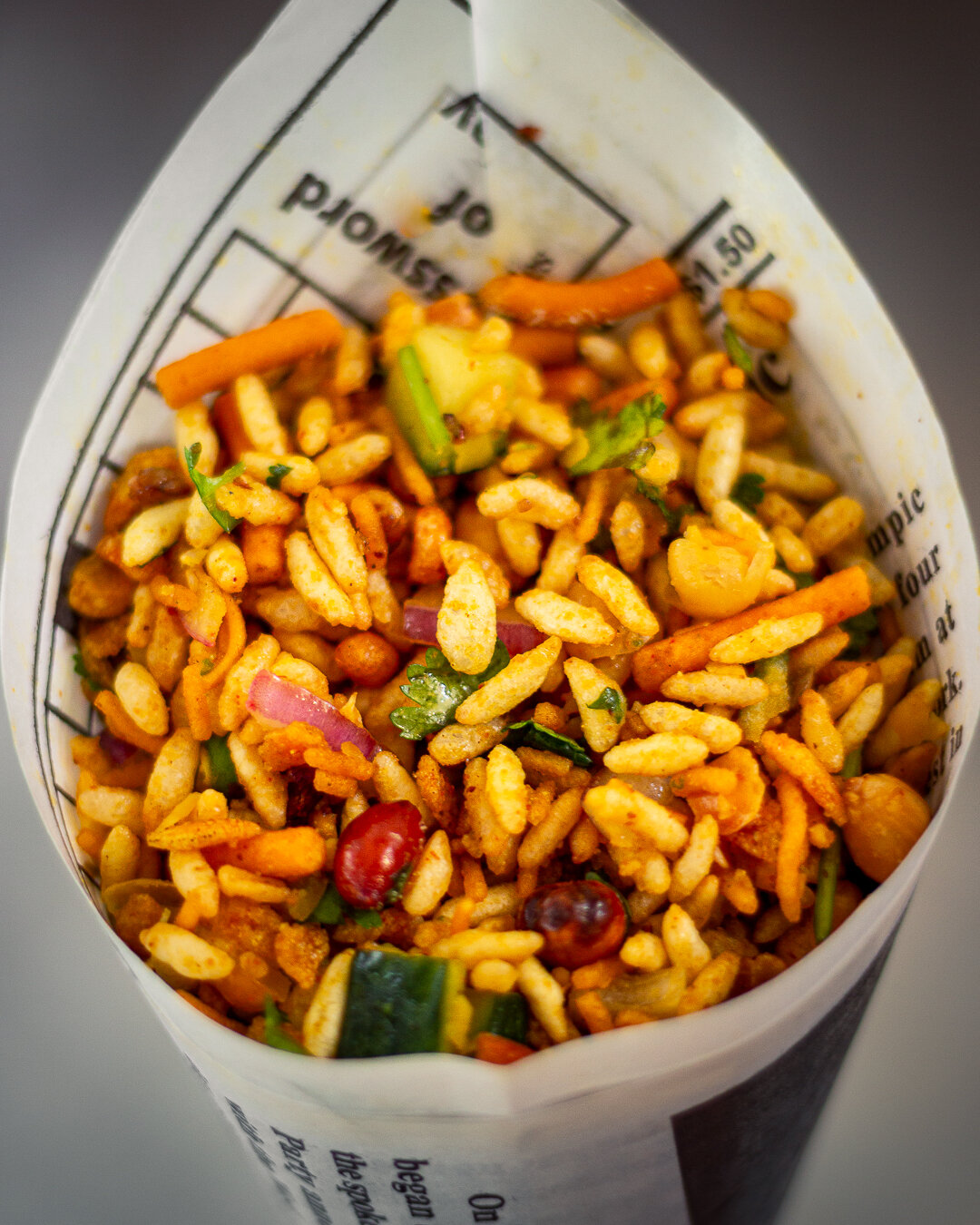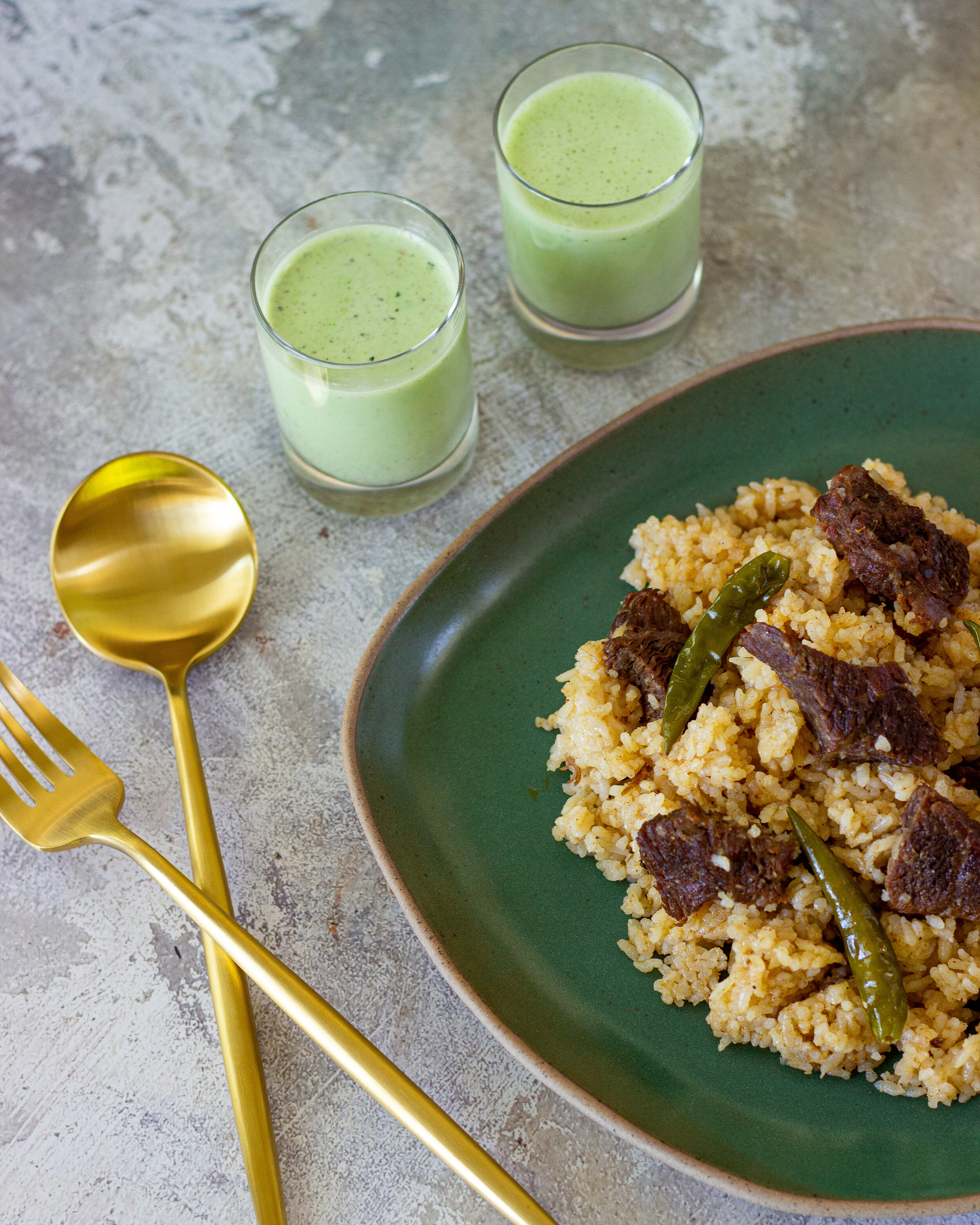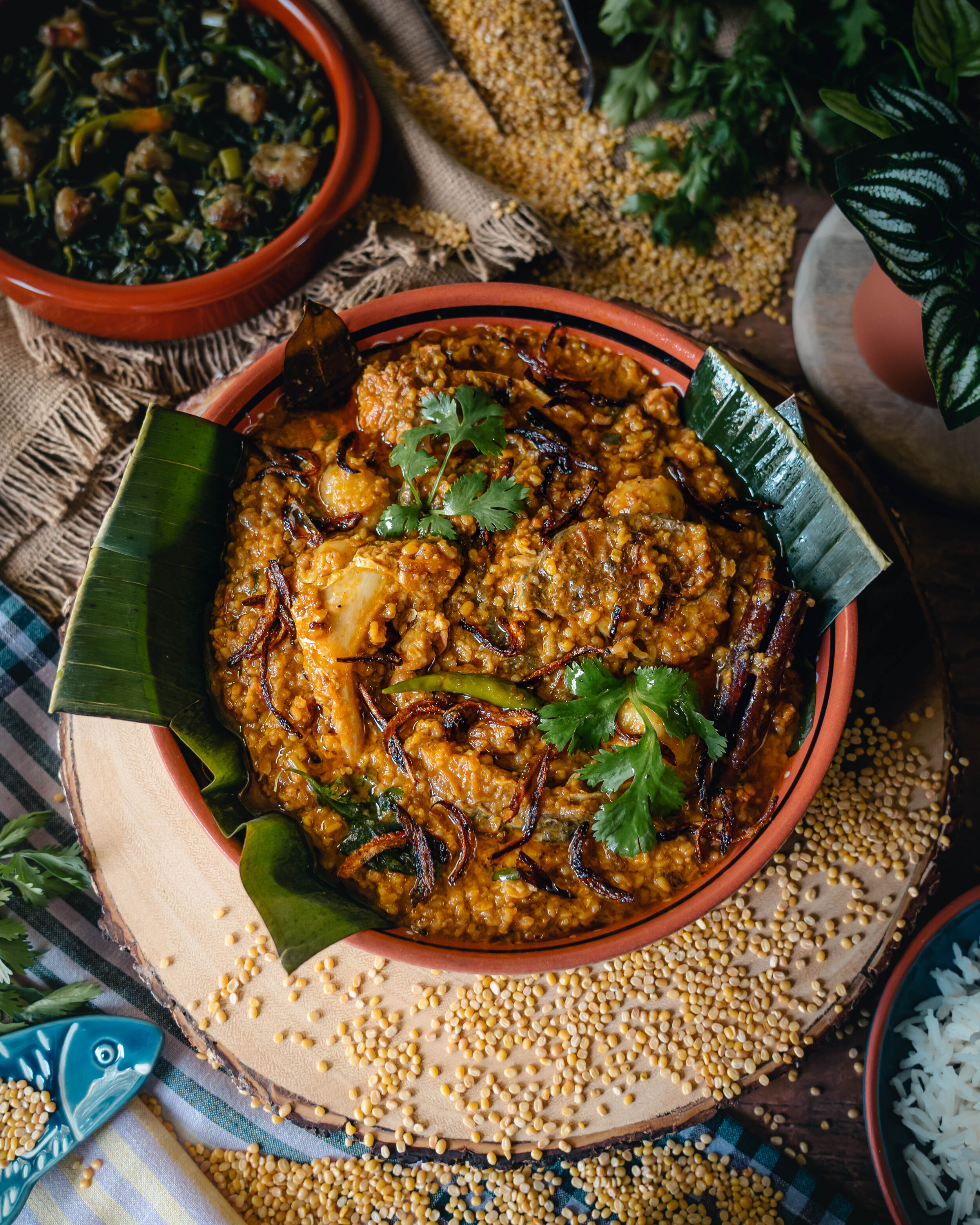Jhalmuri

For the love of Jhalmuri.
A savory mix of puffed rice, chanachur, onions, herbs, green chillies, and pungent mustard oil served in a newspaper cone, just like it is back in the motherland. A simple translation of the name reveals exactly what it’s all about; “jhal” means spicy and “muri” stands for puffed rice, which is the main ingredient and star of this popular street snack.
It’s simple. It’s cheap. It’s delightful. It’s a way to understand our Bengali culture. Jhalmuri feeds a need that is much deeper than hunger, the need to share, to be close to each other. You don’t eat jhalmuri by yourself. In Bangladesh, where street food is pure love and the roadside is a stage, food like jhalmuri is more than a cheap snack, it’s a communion.
Like all connoisseurs, Bengalis have rules for eating jhalmuri too. It must only be eaten out of thongas, cones or bags fashioned out of newspapers. Puffed rice is first poured into the palm, then tossed into your mouth with practiced ease. Don’t ever eat jhalmuri with a spoon. And definitely not alone.
What on earth is a puffed rice?
Puffed rice, which is essentially the same thing as Kellog’s Rice Krispies (a puffed rice cereal popular in the West), is the staple ingredient of any jhalmuri mixture. South Asians have been eating puffed rice long before Kellog’s began marketing it. Puffed rice has been an intrinsic part of our diet for years. Rice is traditionally “puffed”, or turned into muri, by throwing washed and cleaned grains on top of sand heated in a pot. In rural areas, muri is eaten as a snack, and also with curries and cooked vegetables. Muri also plays a significant part in Hinduism, offered as prasads, material substance of vegetarian food to gods and goddesses during poojas (Hindu religious ceremonies).
The origin of Jhalmuri
Jhalmuri originated in the eastern region of the Indian subcontinent. Not much is known about the predecessor but there are other snacks akin to Jhalmuri found outside of Bangladesh and West Bengal. In North and Central India, there is the bhelpuri and in South India, you get churumuri; both are popular street foods and evening snacks enjoyed with a hot cup of cha.
Historically speaking, the culture of street food is not very old in Bengal. Before the late 19th century, there is no mention of street food anywhere in old Bengali literature. Though references to food and meals are plenty, the larger part of the Bengali culinary focus was on the mind and body, mostly through pure and ayurvedic food. This is understandable because in a society ruled by caste and intricate codes of purity, while pollution and spoilage connected with eating and touch, the very existence of street food would have been an abomination and religious blasphemy. Street food became popular during the Bengali Renaissance, which was a cultural, social, intellectual and artistic movement in the Bengal region during the period of the British Indian Empire, from the nineteenth century to the early twentieth century.
From the turn of the century to the 1950s, one hears about various bhajas (fried goods): bulbul-bhaja, share botrish bhaja and haridaser bulbul-bhaja (claimed to be a favourite of Queen Victoria!) ruling the streets of Bengal. Jhalmuri first grew popular on the streets of Kolkata, the former capital of the British Raj, during World War II. Kolkata (then Calcutta) played an important role in the military operations during the war. There was a large influx of labor from eastern Indian states like Bihar, Odisha, and Uttar Pradesh at the time. The migrant workers recognized how crucial the muri was and that there was business potential in selling it as a snack to British soldiers, American officials and the Bengali babus (gentlemen). The modern day street recipe was a combination of Bengali and Bihari palette and eventually became our very own jhalmuri that are consumed in plenty today.
What’s in it?
Apart from muri, you can add varieties of ingredients which include but aren’t limited to: chanachur (bombay mix), roasted peanuts, aloo bhujia, nimki (namakpara), savory fried moong dal, ghugni, chola bhuna, boiled potatoes, *takes a deep breath* tomatoes, cucumbers, sliced onions, herbs, green chillies, lime juice, raw mustard oil… okay okay you get my point. A generous helping of chanachur, a dash of spices, a sprinkle of herbs, a good squeeze of lemon juice and finally a drizzle of raw mustard oil. As these condiments meet, mixed vigorously with a spoon that clangs against the tin bowl, the smell sends the senses reeling.
When it comes to jhalmuri, the recipe is only a mere guideline, but the important thing to keep in mind is to balance the textures and flavors correctly. Making jhalmuri looks easy, but it requires attention to achieve the exact balance of flavours. Too much liquid, and your puffed rice turns soggy. Too less, and it tastes like bits of styrofoam. The chanachur and the wet mix of ingredients should not be so spicy that it overpowers everything else. With mustard oil, as with wasabi and horseradish, less is more.
There is a special jhalmuri moshla (masala) which sets apart the roadside jhalmuris from the homemade ones. You will find it in the recipe below and yes, it is the same one used by all the jhalmuri walas in their street food stalls. This is optional BUT it does add that extra oomph with a sudden wave of nostalgia. I have made jhalmuri both with and without it, and believe me when I tell you, it makes a huge difference. My life was forever changed.
You might be wondering, did I add my sweat and tears into this jhalmuri mix to give it that extra umami? Lol, tricks of the trade baby! Keep on scrolling for the recipe.
Recipe: Jhalmuri
Serves: 3-4
Preparing the Jhalmuri
Dry Ingredients
Bangladeshi Muri or Puffed Rice - 3 cups
Chanachur (Bombay Mix) - 1 cup
Masala Moong Dal - 2 tbsp
Spicy Aloo Bhujia - 2 tbsp
Crunchy Chickpeas - 2 tbsp
Roasted Peanuts - 2 tbsp
Bit Lobon (Black Salt) - 1/4 Tsp
Aamchur (Dry Mango Powder) - 1/4 Tsp
Chaat Masala - 1 tbsp
Wet Ingredients
Red Onions - 2 tbsp, chopped
Coriander - 2 tbsp, chopped
Green Chillies - 5-6, chopped
Lime Juice - 1 tbsp (half a lime)
Mustard Oil - 2 tsp
Boiled Yellow Peas or Ghugni - 2 tbsp
Lime Zest - 2 tsp
Optional
Cucumber - 2 tbsp, chopped
Tomato - 1 tbsp, chopped
Note: I find these two ingredients make the jhalmuri mix soggy because they release so much moisture. It’s up to you if you want to add them.
Assembling the jhalmuri
To make jhalmuri, we need crisp puffed rice. If they are not crisp then you can dry roast them by microwaving for 30 seconds to 1 minute. Set them aside.
In a large mixing bowl, combine all the wet ingredients. Give it a good stir and set aside.
In a separate mixing bowl, combine all the dry ingredients. Toss them well.
Now add the contents from the dry bowl into the wet bowl. Mix them using a rubber spatula or your clean hands.
Taste test for additional salt, mustard oil and green chillies. It’s all about your personal preference of how spicy and pungent you like the jhalmuri to be.
If the mixture is moist, you can add some more muri and chanachur.
Serve it immediately with a gorom (hot) cup of cha!








